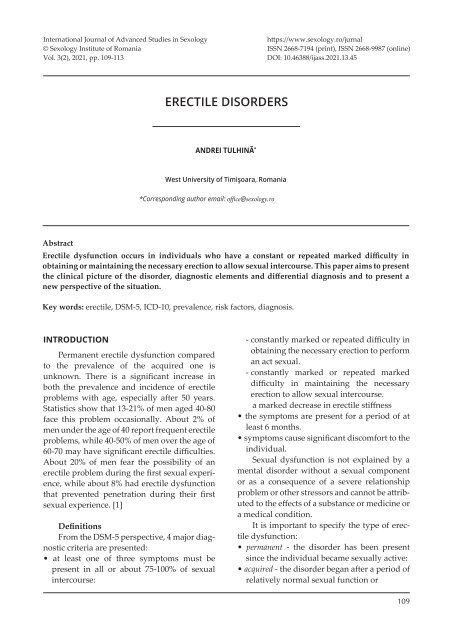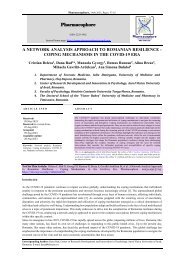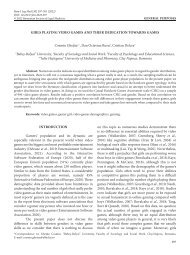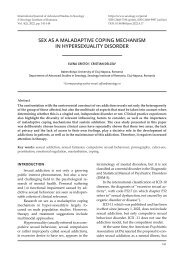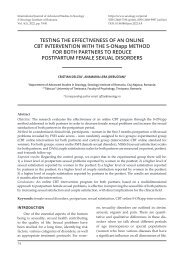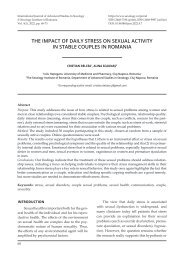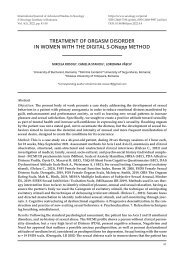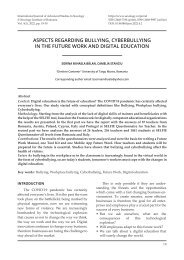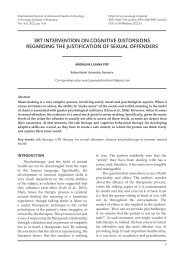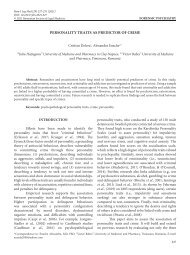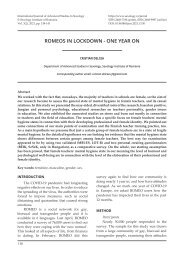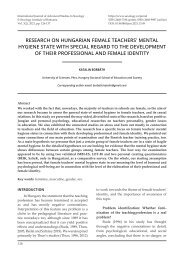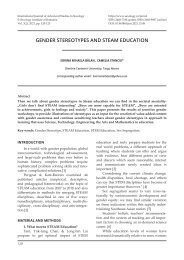Erectile disorders
Erectile dysfunction occurs in individuals who have a constant or repeated marked difficulty in obtaining or maintaining the necessary erection to allow sexual intercourse. This paper aims to present the clinical picture of the disorder, diagnostic elements and differential diagnosis and to present a new perspective of the situation.
Erectile dysfunction occurs in individuals who have a constant or repeated marked difficulty in obtaining or maintaining the necessary erection to allow sexual intercourse. This paper aims to present the clinical picture of the disorder, diagnostic elements and differential diagnosis and to present a new perspective of the situation.
Create successful ePaper yourself
Turn your PDF publications into a flip-book with our unique Google optimized e-Paper software.
International Journal of Advanced Studies in Sexology<br />
© Sexology Institute of Romania<br />
Vol. 3(2), 2021, pp. 109-113<br />
https://www.sexology.ro/jurnal<br />
ISSN 2668-7194 (print), ISSN 2668-9987 (online)<br />
DOI: 10.46388/ijass.2021.13.45<br />
ERECTILE DISORDERS<br />
ANDREI TULHINĂ *<br />
West University of Timişoara, Romania<br />
*Corresponding author email: office@sexology.ro<br />
Abstract<br />
<strong>Erectile</strong> dysfunction occurs in individuals who have a constant or repeated marked difficulty in<br />
obtaining or maintaining the necessary erection to allow sexual intercourse. This paper aims to present<br />
the clinical picture of the disorder, diagnostic elements and differential diagnosis and to present a<br />
new perspective of the situation.<br />
Key words: erectile, DSM-5, ICD-10, prevalence, risk factors, diagnosis.<br />
INTRODUCTION<br />
Permanent erectile dysfunction compared<br />
to the prevalence of the acquired one is<br />
unknown. There is a significant increase in<br />
both the prevalence and incidence of erectile<br />
problems with age, especially after 50 years.<br />
Statistics show that 13-21% of men aged 40-80<br />
face this problem occasionally. About 2% of<br />
men under the age of 40 report frequent erectile<br />
problems, while 40-50% of men over the age of<br />
60-70 may have significant erectile difficulties.<br />
About 20% of men fear the possibility of an<br />
erectile problem during the first sexual experience,<br />
while about 8% had erectile dysfunction<br />
that prevented penetration during their first<br />
sexual experience. [1]<br />
Definitions<br />
From the DSM-5 perspective, 4 major diagnostic<br />
criteria are presented:<br />
• at least one of three symptoms must be<br />
present in all or about 75-100% of sexual<br />
intercourse:<br />
- constantly marked or repeated difficulty in<br />
obtaining the necessary erection to perform<br />
an act sexual.<br />
- constantly marked or repeated marked<br />
difficulty in maintaining the necessary<br />
erection to allow sexual intercourse.<br />
a marked decrease in erectile stiffness<br />
• the symptoms are present for a period of at<br />
least 6 months.<br />
• symptoms cause significant discomfort to the<br />
individual.<br />
Sexual dysfunction is not explained by a<br />
mental disorder without a sexual component<br />
or as a consequence of a severe relationship<br />
problem or other stressors and cannot be attributed<br />
to the effects of a substance or medicine or<br />
a medical condition.<br />
It is important to specify the type of erectile<br />
dysfunction:<br />
• permanent - the disorder has been present<br />
since the individual became sexually active:<br />
• acquired - the disorder began after a period of<br />
relatively normal sexual function or<br />
109
TULHINĂ and CĂDARIU<br />
• generalized - is not limited to certain types of<br />
stimulation, situations or partners<br />
• situational - occurs only in the case of certain<br />
types of stimulation, situations or partners<br />
From the point of view of the current<br />
severity it can be:<br />
• mild - if there are signs of mild suffering<br />
caused by symptoms;<br />
• moderate - if there are signs of moderate<br />
suffering caused by symptoms;<br />
• severe - if there are signs of severe suffering<br />
caused by symptoms; [1]<br />
In ICD-10, the definition of erectile dysfunction<br />
is short and to the point, summarizing<br />
the main problem of men who have difficulty<br />
developing or maintaining an adequate erection<br />
for satisfactory sexual intercourse. [9]<br />
ICD-10 the erectile response is coded as<br />
insufficiency of the genital response. [1]<br />
RISK FACTORS AND FORECAST<br />
Temperament factors. Neurotic personality<br />
<strong>disorders</strong> may be associated with erectile<br />
dysfunction in students, and personality traits<br />
may be associated with erectile dysfunction in<br />
men over 40 years of age. Alexithymia (deficiencies<br />
in cognitive processing of emotions) is<br />
common in men diagnosed with psychogenic<br />
erectile dysfunction. Men with depression and<br />
post-traumatic stress disorder may have erectile<br />
problems.<br />
Factors that change evolution. Risk factors for<br />
erectile dysfunction are: age, smoking, lack of<br />
exercise, diabetes and reduced sexual desire.<br />
[1]<br />
According to multinational studies, erectile<br />
dysfunction in young men is an increasingly<br />
common condition. Careful diagnostic evaluation<br />
should focus on identifying any underlying<br />
etiology to ensure adequate management<br />
for the patients before proceeding with potentially<br />
costly and invasive treatment options. [5]<br />
DIAGNOSIS AND TREATMENT<br />
Diagnostic elements<br />
• The essential diagnostic element of erectile<br />
dysfunction is the repeated inability to get<br />
or maintain an erection during sexual intercourse<br />
with a partner.<br />
(Criterion A).<br />
• The history of sexual activity is important<br />
to determine whether the problem has<br />
been present for a significant period of time (at<br />
least for 6 months) and occurs in most sexual<br />
acts (at least 75% of the time).<br />
• Symptoms may only occur in certain situations<br />
involving certain types of stimulation or<br />
partners or may occur in all types of situations,<br />
stimuli or partners. [1]<br />
Associated elements that support the<br />
diagnosis<br />
In the process of evaluating and establishing<br />
the diagnosis of erectile dysfunction,<br />
other factors that may be relevant to the<br />
etiology and treatment must be considered:<br />
• factors related to the partner (eg sexual problems<br />
of the partner or his state of health);<br />
• sexual activity;<br />
• factors related to the individual’s vulnerability<br />
(negative image of one’s own body,<br />
history of sexual or emotional abuse, depression,<br />
anxiety, stressors);<br />
• cultural / religious factors (inhibitions related<br />
to the prohibition of sexual activity, attitude<br />
towards sexuality;<br />
• medical factors relevant to prognosis, evolution<br />
and treatment. [1]<br />
Debut and evolution<br />
Failure to get an erection during the first<br />
sexual experience is related to:<br />
• unknown partner until the act of intercourse;<br />
• drug or alcohol use;<br />
• lack of desire to have sex.<br />
These problems resolve spontaneously<br />
without specialized intervention, but some<br />
men may experience episodic symptoms. [1]<br />
Acquired erectile dysfunction is often<br />
associated with biological factors such as<br />
diabetes and cardiovascular disease and tends<br />
to persist. The natural history of permanent<br />
erectile dysfunction is unknown, and the<br />
clinical examination associates the symptoms<br />
with self-limited psychological factors or those<br />
that respond to psychological interventions,<br />
110
<strong>Erectile</strong> disorder<br />
as opposed to the acquired one which is still<br />
persistent but associated with biological<br />
factors. [1]<br />
Through its connection with self-image<br />
and sexual problems, erectile dysfunction can<br />
cause psychological damage. [8]<br />
Diagnostic elements dependent on the<br />
cultural environment<br />
The symptoms of erectile dysfunction vary<br />
in different countries. It is not clear to what<br />
extent these differences represent differences<br />
resulting from cultural expectations, or real<br />
differences in the frequency of inability to<br />
obtain an erection. [1]<br />
Sexual dysfunction in older men is a<br />
dynamic disorder whose incidence and remission<br />
are predicted by a number of modifiable<br />
risk factors.<br />
The incidence of erectile dysfunction in<br />
relation to biopsychosocial factors, sociodemographic<br />
factors, with lifestyle and of health was<br />
described. The highest incidence of erectile<br />
dysfunction was observed in men with: older<br />
age, lower income, higher mass of abdominal<br />
adipose tissue, reduced alcohol consumption,<br />
higher risk of obstructive sleep apnea,<br />
lower urinary tract symptoms, depression and<br />
diabetes. The lower incidence was observed in<br />
younger men who have work and the absence<br />
of other diseases such as ischemic heart disease,<br />
diabetes and dyslipidemia. [3]<br />
About one in three men in New Zealand,<br />
aged between 40 and 70, has erectile dysfunction.<br />
Although it is comparable to populations<br />
in neighboring geographical areas, this prevalence<br />
is high. [7]<br />
Premature ejaculation is higher than erectile<br />
dysfunction in Asia-Pacific countries. 45%<br />
of men diagnosed with premature ejaculation<br />
and erectile dysfunction were dissatisfied<br />
with the duration of sexual intercourse before<br />
ejaculation, their control over ejaculation and,<br />
respectively, sexual intercourse. [6]<br />
Diagnostic markers<br />
Useful methods in differentiating organic<br />
erectile problems from psychogenic ones are:<br />
testing nocturnal penile intumescence and<br />
measuring erectile turgor during sleep. At the<br />
base of this differentiation is the theory that<br />
adequate erections during sleep with rapid eye<br />
movements indicate a psychological etiology<br />
of the problem.<br />
Depending on the doctor’s decision, other<br />
diagnostic procedures can be performed:<br />
• Doppler ultrasonography<br />
• intravascular injection of vasoactive drugs<br />
• cavernosonography with dynamic injection<br />
• studies of impulse conduction at the level of<br />
the shameful nerve<br />
• serum bioavailability of free testosterone<br />
• investigation of thyroid function<br />
• determining the existence of diabetes by<br />
determining fasting blood glucose<br />
• measuring the concentration of plasma<br />
lipids. [1]<br />
Differential diagnosis<br />
Mental <strong>disorders</strong> without sexual<br />
component.<br />
Major depressive disorder and erectile<br />
dysfunction are closely associated and there<br />
are cases where erectile dysfunction coexists<br />
with major depressive disorder.<br />
Normal erectile function should be<br />
considered in men with exaggerated<br />
expectations.<br />
Substance and drug use - has a specific onset<br />
of the disorder that coincides with the beginning<br />
of the administration of the substance or drug<br />
and disappears upon discontinuation or<br />
reduction of dose.<br />
Medical conditions The difference between<br />
erectile dysfunction as a mental disorder and<br />
erectile dysfunction as a result of a medical<br />
condition is usually unclear and many cases<br />
have complex psychological and psychiatric<br />
etiologies that influence each other. If the<br />
individual is over 40-50 years old and / or has<br />
concomitant medical problems, the differential<br />
diagnosis should include medical etiologies<br />
such as diabetes. Age under 40 is suggestive of<br />
the psychological etiology of the disorder.<br />
Other sexual dysfunctions <strong>Erectile</strong><br />
dysfunction can coexist with premature<br />
ejaculation and hypoactive sexual desire<br />
disorder in men. [1]<br />
111
TULHINĂ and CĂDARIU<br />
Comorbidities<br />
- Premature ejaculation Disorder of hypoactive<br />
sexual desire in men<br />
- Anxiety and depressive disorder, Prostate<br />
hypertrophy with lower urinary tract<br />
symptoms<br />
- Dyslipidemia<br />
- Cardiovascular disease Hypogonadism<br />
Multiple sclerosis Diabetes mellitus [1]<br />
<strong>Erectile</strong> dysfunction and premature ejaculation<br />
are reported by one in six infertile<br />
patients. <strong>Erectile</strong> dysfunction is mainly associated<br />
with depressive symptoms and with<br />
symptoms and signs of prostatitis, phobic<br />
anxiety. [2]<br />
Treatment of erectile dysfunction<br />
The treatment of erectile dysfunction has<br />
evolved with scientific research involving from<br />
psychotherapy and treatments based on plant<br />
extracts, to more complex surgical and drug<br />
therapies, even studying treatments based on<br />
genetic transformations, which are still in the<br />
research stage. The treatment consists of:<br />
• administration of medicinal preparations,<br />
• surgical treatment - performing surgical<br />
interventions,<br />
• family counseling,<br />
• changing lifestyle and often the psycho-emotional<br />
relationship with the partner,<br />
• exclusion of risk factors,<br />
• treatment of associated diseases. [4]<br />
CONCLUSION<br />
<strong>Erectile</strong> dysfunction mainly affects men<br />
aged 50-59 years, and their number increases<br />
with age. However, erectile dysfunction is<br />
not a normal part of the aging process and<br />
can occur even in young men. In most cases,<br />
the dysfunction does not occur suddenly, but<br />
gradually sets in. Various studies on the health<br />
and habits of the subjects managed to identify<br />
several factors that increase the risk of erectile<br />
dysfunction. Most often, these factors risk acts<br />
simultaneously. Mainly through its connection<br />
with self-image and sexual problems, erectile<br />
dysfunction can cause major psychological<br />
damage.<br />
BIBLIOGRAPHY<br />
1. American Psychiatric Association. (2013). DSM<br />
5. 426-429 pg. Editura Callistro.<br />
2. Lotti F, Corona G, Rastrelli G, Forti G, Jannini<br />
EA și Maggi M. Clinical Correlates of <strong>Erectile</strong><br />
Dysfunction and Premature Ejaculation in Men<br />
with Couple Infertility. The Journal of Sexual<br />
Medicine,Volume 9, Issue 10, October 2012,<br />
Pages 2698-2707 https://pubmed.ncbi.nlm.nih.<br />
gov/228977 16/<br />
3. Martin SA, Atlantis E, Lange K, Taylor AW,<br />
O’Loughlin P, Wittert GA, and members<br />
of the Florey Adelaide Male Ageing Study<br />
(FAMAS). Predictors of sexual dysfunction<br />
incidence and remission in men. The Journal<br />
of Sexual Medicine,2014;11:1136–1147. https://<br />
onlinelibrary.wiley.com/doi/abs/1 0.1111/<br />
jsm.12483<br />
4. Ministerul Sănătății al Republicii Moldova.<br />
Disfuncţia erectile Protocol clinic naţional<br />
PCN-261 http://msmps.gov.md/wp- content/<br />
uploads/2020/06/15250-PCN- 261.pdf<br />
5. Nguyen HMT, Gabrielson AT, Hellstrom WJG.<br />
<strong>Erectile</strong> Dysfunction in Young Men—A Review<br />
of the Prevalence and Risk Factors. The Journal<br />
of Sexual Medicine,Rev 2017;5:508–520. https://<br />
pubmed.ncbi.nlm.nih.gov/286420 47/<br />
6. Park JK, and Adaikan PG. Premature ejaculation<br />
and erectile dysfunction prevalence and<br />
attitudes in the Asia‐ Pacific region. The Journal<br />
ofSexual Medicine, 2012;9:454–465. https://<br />
pubmed.ncbi.nlm.nih.gov/220233 95/<br />
7. Quilter M, Hodges L, von Hurst P și colab. Male<br />
Sexual Function in New<br />
8. Zealand: A Population-Based Cross- Sectional<br />
Survey of the Prevalence of <strong>Erectile</strong> Dysfunction<br />
in Men Aged 40–70 Years. The Journal of Sexual<br />
Medicine,2017; 14: 928-936.<br />
9. https://pubmed.ncbi.nlm.nih.gov/2867343 5/<br />
10. Wikipedia https://en.wikipedia.org/wiki/<br />
<strong>Erectile</strong>_dysf unction<br />
11. World Health Organization. (2019). ICD 10 –<br />
F52.2.<br />
12. Delcea C., Siserman C., 2020: Validation<br />
and Standardization of the Questionnaire<br />
for Evaluation of Paraphilic Disorders. Rom<br />
J Leg Med28(1)14-20(2020) DOI:10.4323/<br />
rjlm.2020.14Romanian Society of Legal<br />
Medicine<br />
13. Siserman C., Delcea C., Vladi Matei H.,<br />
Vică L. M. 2019: Major Affective Distres in<br />
Testing Forensic Paternity. 2019. - Rom J<br />
112
<strong>Erectile</strong> disorder<br />
Leg Med27(3)292-296(2019) DOI:10.4323/<br />
rjlm.2019.292 © Romanian Society of Legal<br />
Medicine.<br />
14. Delcea C., Rusu O. D., Matei V. H., Vica<br />
M. L., Siserman C., (2020). The Evidence-<br />
Based Practice Paradigm Applied to Judicial<br />
Psychological Assessment In The Context of<br />
Forensic Medicine. Rom J Leg Med [28] 257-262<br />
[2020] DOI: 10.4323/rjlm.2020.257.<br />
15. Siserman C., Giredea C., Delcea C., (2020).<br />
The Comorbidity of Paraphilic Disorders and<br />
Rape In Individuals Incarcerated For Sexual<br />
Offences. Rom J Leg Med [28] 278-282 [2020]<br />
DOI: 10.4323/rjlm.2020.278.<br />
113


